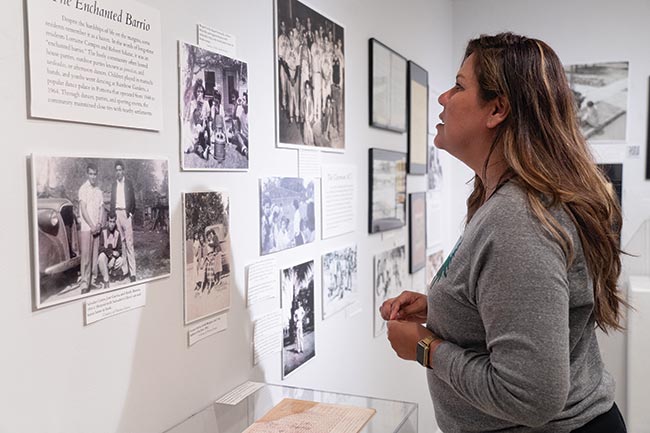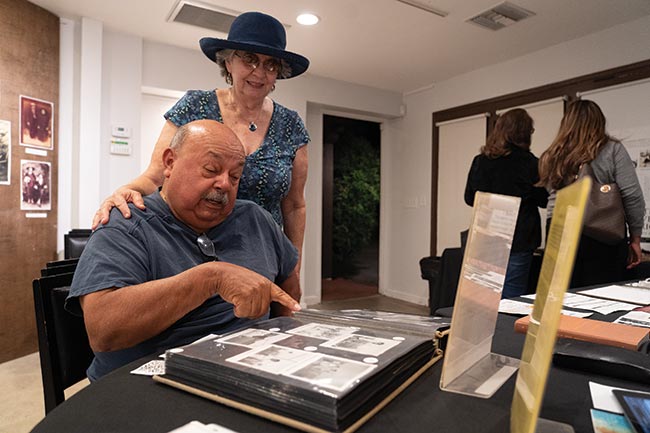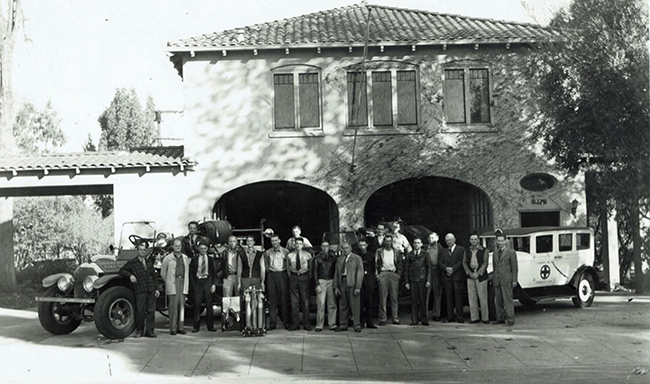The history underfoot: ‘Stories from the East and West Barrios’ at Ginger Elliott

Jennifer Gomez tours “Stories from the East and West Barrios” last week at the Ginger Elliott Exhibition Center. Courier photo/Andrew Alonzo
By Andrew Alonzo | aalonzo@claremont-courier.com
Los Angeles resident Charles Lewis pointed to a photo hanging on the south wall last week at Claremont Heritage’s Ginger Elliott Exhibition Center. The 1928 photo featured his grandmother, Florence, then a student at Escuela Mexicana, The Mexican School, inside Pomona College’s Gymnasium Hall.
Lewis’ mother Victoria used her walker to hoist herself up for a closer look before letting out a laugh. Moving a few paces north, the mother and son faced familiar, nostalgic images: Lola’s El Chisme grocery store, where a young Lewis bought snow cones; and a 1985 portrait featuring the patriarchs and matriarchs of the family.
“You’re trying to put everyone in place,” Charles Lewis said, when asked what was going through his mind. Despite not being in the photos himself, he said he felt a sense of pride and acknowledgment from the images featured in Claremont Heritage’s “Stories from the East and West Barrios” at the Ginger Elliott.

John Dominguez and Lydia Henry, both longtime Arbol Verde residents and consultants for Claremont Heritage’s exhibit, “Stories from the East and West Barrios,” peer through a scrapbook by Marilyn Noble last week at the Ginger Elliott Exhibition Center. Courier photo/Andrew Alonzo
Accompanying them on their tour was Lydia Henry, a longtime Arbol Verde resident and a community consultant for the project. She described scenes of El Barrio Park in its heyday, Sacred Heart Chapel before it was displaced by the construction of Claremont Boulevard, youth and family programs, former businesses, and a team photo of The Claremont AC’s, a semiprofessional baseball team that played in a Mexican League that encompassed the Inland Empire.
“I mean they can fill up lots more with a lot more history,” Henry said of the gallery walls, noting the extensive roots the Arbol Verde neighborhood has in Claremont. The show includes about 50 images and 20 pieces of memorabilia. It was just one component of a larger project meant to highlight the city’s barrios, which overlapped both San Bernardino and Los Angeles counties.
Claremont Heritage was awarded $5,000 last year from California Humanities, a state affiliate of the National Endowment of the Humanities, which it used to fund community educational projects such as “Stories from the East and West Barrios,” as well as a scrapbook by longtime Arbol Verde resident Marilyn Noble, and to fund a documentary film, “Stories from the Barrios,” which will be screened at 7 p.m. Thursday, September 28 at Claremont Graduate University’s Albrecht Auditorium, 925 N. Dartmouth Ave. The event is free and open to the public and will be followed by a panel discussion with John Dominguez, another community consultant for the project.
“The exhibit is about the historically segregated Mexican American community of Claremont, Upland, and Montclair,” said Chelsea Liu, a former Claremont Heritage archivist who curated the exhibit. “This exhibit is really trying to cover a fairly comprehensive history of the barrios, from its establishment in the 1910s all the way to the present day.”
The exhibit and scrapbook include archived and donated photos sourced from the community, The Claremont Colleges Library, newspaper articles, and other ephemera related to Arbol Verde.
“These stories really haven’t been recognized in a comprehensive exhibition before,” Liu said. “There has been prior academic scholarship by people like Matt Garcia … but there really hasn’t been any kind of widespread recognition of this history which I think needs to be addressed,” adding there are many residents and college students today who are unaware of the abundant history under their feet. Liu also singled out Gilda Ochoa’s oral history project and a film by Dr. Gina Lamb and her students at Pitzer College as helping to reveal these oft neglected stories.
Much of the exhibit deals with themes of institutional racism, segregation, displacement, and the discriminatory land use policies that led to the creation of the barrio neighborhoods. “I think there is a need to face up to difficult histories, confront past and ongoing racism, and commit to upholding diversity in the city of Claremont,” Liu wrote in a text message.
The Heritage exhibit closes Thursday, September 28, the same day of the documentary screening.
The film includes several interviews with Arbol Verde residents that will later be uploaded to the Claremont Colleges Digital Library and the Online Archive of California. It also sheds light on the storied neighborhood.
Since its September 2 opening, locals in and around Claremont have viewed the exhibit, sparking many conversations and stories.
Dominguez, a lifelong resident of Arbol Verde, talked about what it meant to highlight these abundant stories.
“I think it’s important for history,” he said. “It has to be remembered that Claremont was founded at the turn of the 20thcentury, and many of the early settlers here were Mexicans who came up from Mexico to escape the revolutions that were in Mexico. And they helped contribute to the building of the city through the colleges, working the [Claremont] Packing House to pick the citrus industry. They were a large and vital part of the community.”
“Stories from the East and West Barrios,” at the Ginger Elliott Exhibition Center, 840 N. Indian Hill Blvd., is open from 10 a.m. to 3 p.m. Monday through Friday through September 28. Admission is free but donations are welcome.
With another recent $10,000 grant from the Union Pacific Community Ties Giving Program, Claremont Heritage aims to expand upon “Stories from the East and West Barrios.”
“I think with the oral interview grant that Lydia helped [Claremont Heritage Executive Director David Shearer] write, it’s coming together and we’re putting more emphasis on more oral interviews and more history,” Dominguez said. “I hope this is just the start of a larger, greater expansion of the project.”
Though the exhibit will close September 28, Claremont Heritage is still accepting photos, clippings and other items relating to Arbol Verde and its history for its ongoing Claremont Barrio Project. Call (909) 621-0848 for more information.










0 Comments